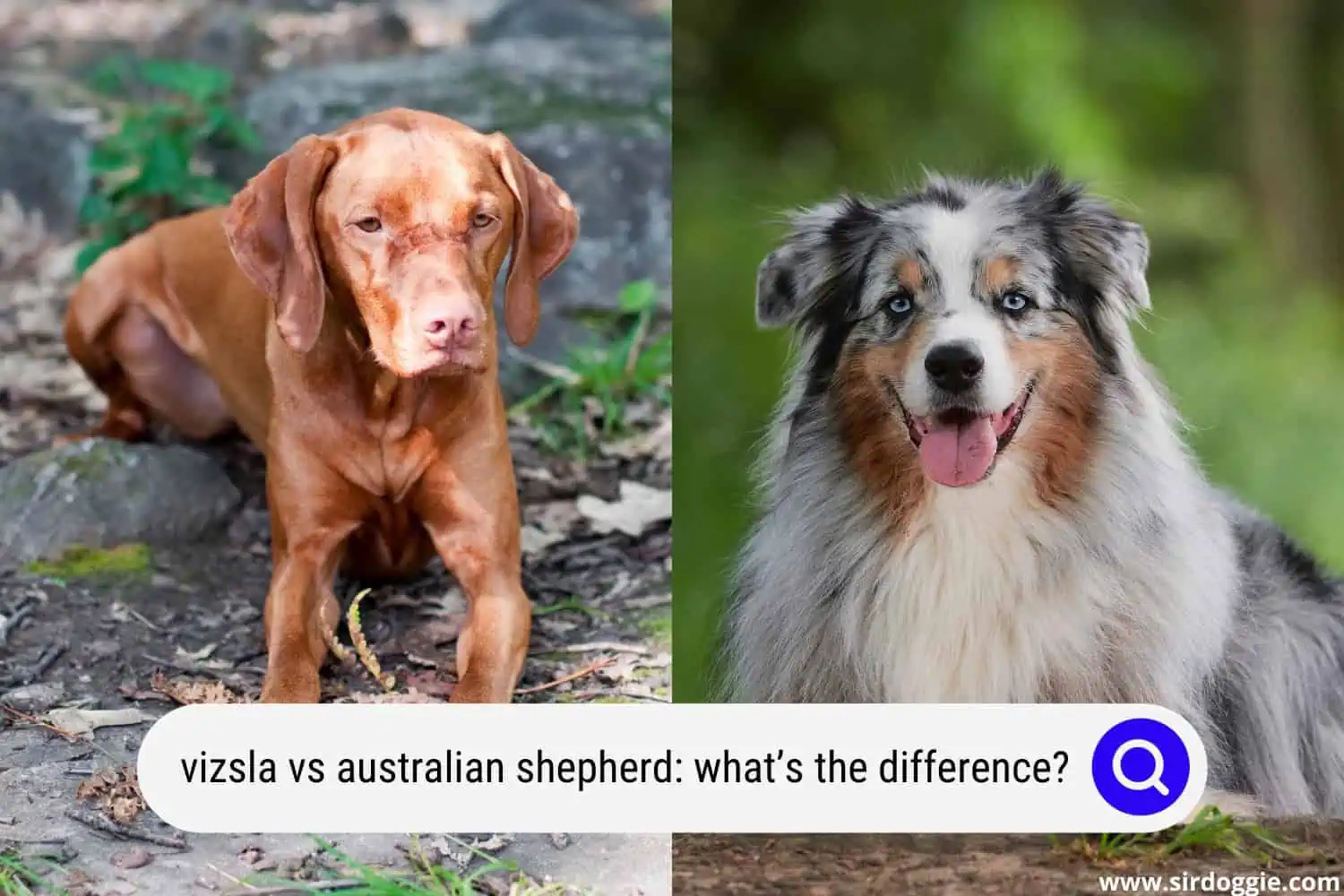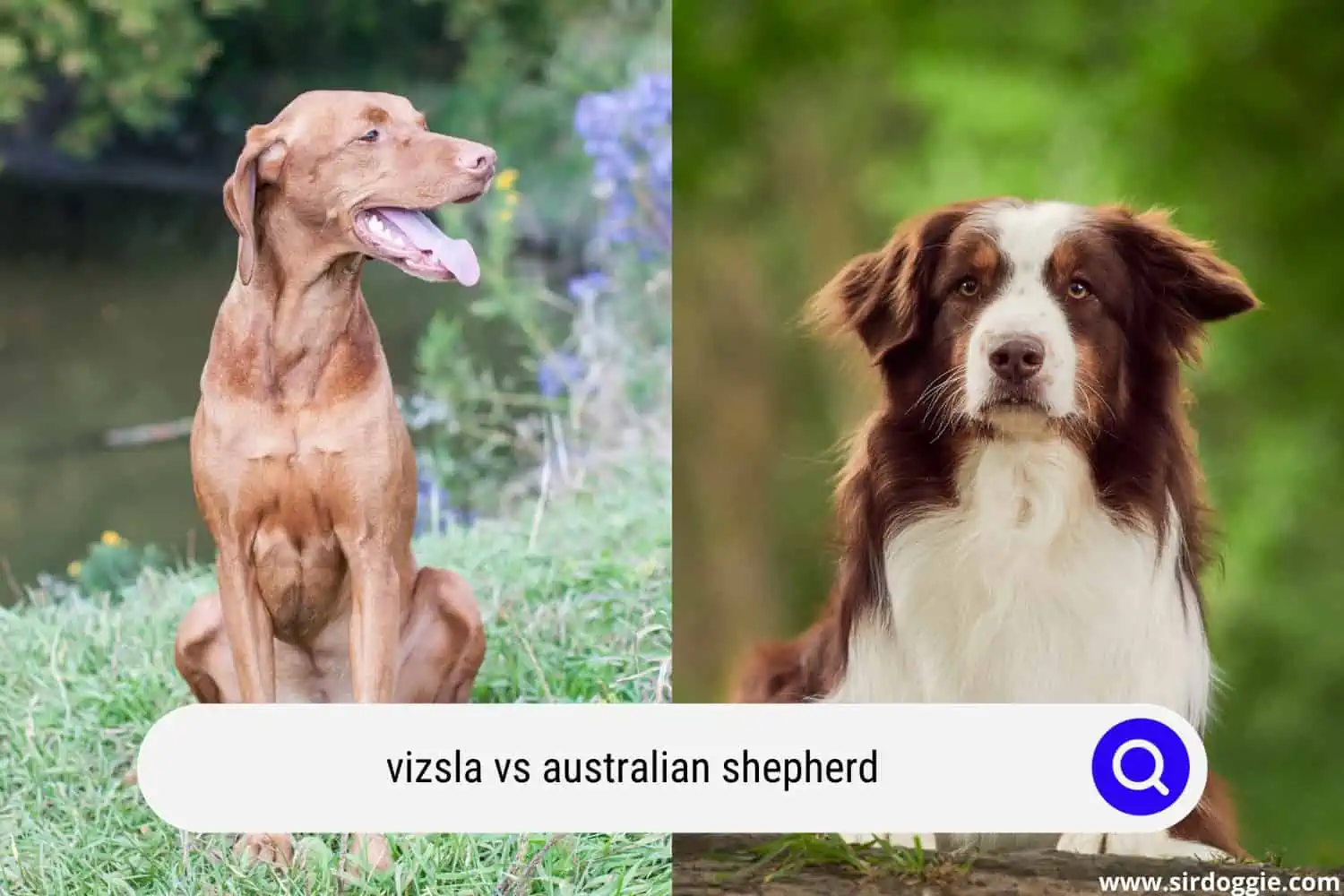Vizsla vs Australian Shepherd: What’s the Difference?
The Australian Shepherd is more popular than the Vizsla, even though the latter got the AKC recognition much earlier than the former.

But aside from popularity, both breeds are almost of the same height and weight. However, the Australian Shepherd is more tolerant of cold and lives longer than the Vizsla. But is that enough reason to choose an Australian Shepherd over a Vizsla? Wait till you finish with the article!
In this Vizsla vs Australian Shepherd comparison article, we’ll see the characteristics, character, health life, and life span, as well as the care needs of each breed so you can be guided on which one to choose, depending on your needs and lifestyle. First comes the Vizsla!
Related Reading: Vizsla vs Coyote: All You Need to Know
The Vizsla: a versatile hunting and family dog
The Vizsla is an excellent versatile hunting dog, which will adapt to all types of terrain. It is a dog that attaches itself very quickly to its social group and can quickly create a strong relationship with its master. It is also one of the excellent breeds of family dogs that will get along with all of its members.
The history of the Vizsla
The Vizsla is a versatile hunting dog, originally from Hungary as its second suggests. Particularly appreciated by hunters, it successfully participated in many Hungarian pointers competitions from the 19th century. The FCI recognized the breed in 1936, then definitively in 1954.
The Vizsla saw and participated actively in the Turkish occupation (1526 to 1696), the Hungarian Civil War (1848 to 49), World War I, World War II as well as the Russian Occupation.
It went almost extinct following the World Wars, but thanks to the conservative actions of some Hungarians, some of the animals were saved, and kept, and the breed multiplied again.
Physical characteristics of the Vizsla dog
Also called the Hungarian pointer and the Magyar Vizsla, the pointing dog is medium in size.
Its height at the withers stands between 58 and 64 cm for males and between 54 and 60 cm for females. Their weight is between 22 and 30 kg for males and between 20 and 28 kg for females. However, it is the smallest pointer dog in the world.
The Vizsla can have a uniform coat that can be made up of several gradations of golden wheat. White markings on the chest, the throat, or the fingers can be found in some.
The coat of the Vizsla is, unsurprisingly, short, tight, coarse, and with a hard texture. The hair is finer on the head and ears. The Vizsla does not have an undercoat.
The eyes of the Vizsla are medium in size, oval in shape, and dark brown. The Vizsla’s ears are carried slightly back, set neither too high nor too low, and form a rounded “V” at the ends.
The tail of the Vizsla is set low, strong at the base, and thinner at the tip. If it is not cropped, the tail of the Vizsla is carried straight or in a lightsaber.
Vizsla Character
The Vizsla is a versatile, resistant, and lively hunting dog. it is also very balanced, affectionate, and docile. it is neither fearful nor aggressive towards others and is very attached to its master. This makes it a very pleasant life and work companion.
The Vizsla needs to be active, so it needs daily outings in large spaces where it can move freely to be fully developed. Also, its attraction for work makes it a dog, particularly in demand of exercises that will stimulate both its intellect but also its sense of smell.
Possible activities with the Vizsla are walking, tracking, hunting, obeying, agility, cani-crossing, climbing and mountaineering, biking, etc.
Apartment life will only be possible if the Vizsla enjoys several quality daily outings and not simple hygienic walks in the neighborhood.
The Vizsla is a sociable dog that can easily coexist with other animals but early and quality socialization will be necessary to ensure everyone’s peace of mind.
The health of the Vizsla
Health-wise, the Vizsla is a very robust dog breed. However, hip dysplasia is one of the most common health problems of the breed. But this problem is only common in those used for sports, hunting, or other rigorous activities. Cancer and other heart-related problems are other health issues in the breed.
The life span of the Vizsla is between 12 to 15 years, according to the World Life Expectancy.
The Australian Shepherd: the adaptable sheepdog
The Australian Shepherd is a shepherd dog particularly appreciated for its unique coat and energetic character. This dog breed requires a lot of attention as well as physical and mental expense.
So if you want to adopt an Australian Shepherd, know that its training begins in its second month. And you will have to offer it enough activity to meet its needs as a working dog.
History and Origins of the Australian Shepherd
The Australian Shepherd originally comes from the Basque Country. Some Basques emigrated to Australia accompanied by their dogs and their cattle, mainly sheep. It was in the 1900s that these dogs arrived from Australia to the United States. It was then that farmers developed this breed and even today the Australian Shepherd is used for herding on American ranches.
Physical characteristics of the muscular Australian Shepherd
The size of the Australian Shepherd is between 51 and 58 cm for males and between 46 and 53 cm for females. The average weight of the breed varies between 25 and 34 kg for males and between 19 and 26 kg for females.
Perfectly well proportioned. The body of the Australian Shepherd, however, is a bit longer than it is tall. Solidly constituted, it has a beautiful musculature. Like the Vizsla, it is a medium-sized dog that is muscular without being heavy.
The skull is well-proportioned (as wide as it is long). The stop is moderate. The head of this dog is harmonious, sharply defined, and well-proportioned to the rest of its body.
Character of the Australian Shepherd
As the name suggests, the Australian Shepherd is a sheepdog. This means that it has a strong herd instinct and a strong need to be useful. In this, you must understand that the character of the Australian Shepherd is logically modeled by its uses. It can be sensitive but also determined. Regardless, it is generally a very adaptable dog.
Australian shepherds are not too inclined to bark but they easily develop a behavior of barking because of stress, anxiety, or boredom.
Like most breeds, the Australian Shepherd can live with children of all ages. However, it is advisable to respect certain safety rules for good cohabitation, such as never leaving a child and a dog alone unattended!
This dog can cohabit without problem with other animals. Let’s not forget that this breed of dog is particularly used on American ranches. However, for this cohabitation to take place as well as possible, your dog must mix with these other species from an early age.
The Health of the Australian Shepherd
Among other genetic diseases of the Australian Shepherd, the breed is likely to be affected by congenital problems. The ductus arteriosus is a common birth defect in the Australian Shepherd, especially in females of the breed.
Polydactyly (presence of an additional finger), syndactyly (fusion of two fingers), and deafness may also be part of congenital problems encountered in the Australian Shepherd.
It can develop eye diseases, including retinal atrophy. Thus, it is advisable to carry out screening tests to ensure the good eye health of your dog. Note that the breeder must give the parents an “Eye Disease Free” certificate when selling a puppy.
Dysplasia of the hips and elbows and skin problems are other health problems. The life expectancy of the Australian Shepherd fluctuates on average between 13 and 15 years.
Vizsla vs Australian Shepherd: Comparison Table
| Vizsla | Herding dogs, family dogs, police dogs, | |
| Type of dog | Pointing dog, retriever dog, family dog | Herding dogs, family dogs, police dog, |
| Origin | Hungary | The Basque Country |
| Other names | Hungarian pointer, Magyar Vizsla | Pastor Dog, New Mexican Shepherd, Bob-Tail, California Shepherd |
| Size | Height at the withers: between 58 and 64 cm for males and between 54 and 60 cm for females Weight: between 22 and 30 kg for males and between 20 and 28 kg for females. | Height at the withers: between 51 and 58 cm for males and between 46 and 54 cm for females Weight: between 23 and 29 kg for males and between 14 and 20 kg for females. |
| Cohabitation with other animals | Possible | Possible |
| Acquisition cost | $1,500 to $2,200 | $600 to $800 |
| Life expectancy | 12 to 15 years | 13 to 15 years |

Conclusion
The Vizsla is a strong, versatile, robust, and very resistant dog. Despite the lack of an undercoat, it adapts very well and resists different climates. However, the Australian Shepherd is a good herding dog that is also used for policing.
While the Australian Shepherd is known for its excessive barking, the Vizsla barks, but not as much as the former. Also, the Australian Shepherd is less expensive and has a slightly longer life expectancy.
As working dog breeds, both the Vizsla and the Australian Shepherds need regular exercise to exert themselves both physically and mentally when used outside of work. They need one to two hours of fairly intense physical activity per day to meet these needs.

Family Dog Expert Author
Hi there! I’m Stuart, a devoted dog lover and family dog expert with over a decade of experience working with our furry companions. My passion for dogs drives me to share my knowledge and expertise, helping families build strong, loving bonds with their four-legged friends. When I’m not writing for SirDoggie, you’ll find me hiking, playing with my beautiful dog, or studying music.